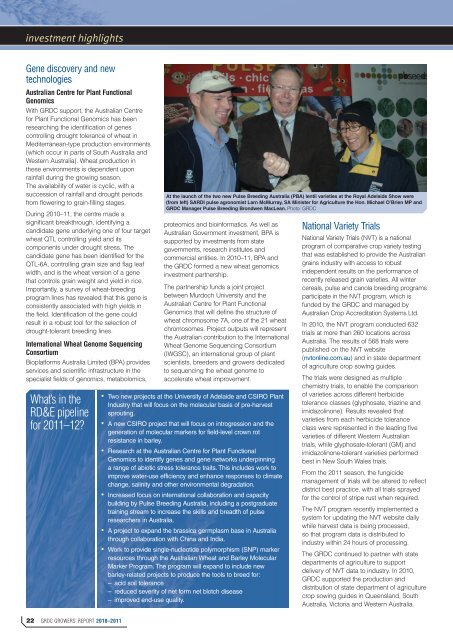grdc growers' report - Grains Research & Development Corporation
grdc growers' report - Grains Research & Development Corporation
grdc growers' report - Grains Research & Development Corporation
Create successful ePaper yourself
Turn your PDF publications into a flip-book with our unique Google optimized e-Paper software.
investment highlights<br />
Gene discovery and new<br />
technologies<br />
Australian Centre for Plant Functional<br />
Genomics<br />
With GRDC support, the Australian Centre<br />
for Plant Functional Genomics has been<br />
researching the identification of genes<br />
controlling drought tolerance of wheat in<br />
Mediterranean-type production environments<br />
(which occur in parts of South Australia and<br />
Western Australia). Wheat production in<br />
these environments is dependent upon<br />
rainfall during the growing season.<br />
The availability of water is cyclic, with a<br />
succession of rainfall and drought periods<br />
from flowering to grain-filling stages.<br />
During 2010–11, the centre made a<br />
significant breakthrough, identifying a<br />
candidate gene underlying one of four target<br />
wheat QTL controlling yield and its<br />
components under drought stress. The<br />
candidate gene has been identified for the<br />
QTL-6A, controlling grain size and flag leaf<br />
width, and is the wheat version of a gene<br />
that controls grain weight and yield in rice.<br />
Importantly, a survey of wheat-breeding<br />
program lines has revealed that this gene is<br />
consistently associated with high yields in<br />
the field. Identification of the gene could<br />
result in a robust tool for the selection of<br />
drought-tolerant breeding lines.<br />
International Wheat Genome Sequencing<br />
Consortium<br />
Bioplatforms Australia Limited (BPA) provides<br />
services and scientific infrastructure in the<br />
specialist fields of genomics, metabolomics,<br />
What’s in the<br />
RD&E pipeline<br />
for 2011–12<br />
At the launch of the two new Pulse Breeding Australia (PBA) lentil varieties at the Royal Adelaide Show were<br />
(from left) SARDI pulse agronomist Larn McMurray, SA Minister for Agriculture the Hon. Michael O’Brien MP and<br />
GRDC Manager Pulse Breeding Brondwen MacLean. Photo: GRDC<br />
proteomics and bioinformatics. As well as<br />
Australian Government investment, BPA is<br />
supported by investments from state<br />
governments, research institutes and<br />
commercial entities. In 2010–11, BPA and<br />
the GRDC formed a new wheat genomics<br />
investment partnership.<br />
The partnership funds a joint project<br />
between Murdoch University and the<br />
Australian Centre for Plant Functional<br />
Genomics that will define the structure of<br />
wheat chromosome 7A, one of the 21 wheat<br />
chromosomes. Project outputs will represent<br />
the Australian contribution to the International<br />
Wheat Genome Sequencing Consortium<br />
(IWGSC), an international group of plant<br />
scientists, breeders and growers dedicated<br />
to sequencing the wheat genome to<br />
accelerate wheat improvement.<br />
• Two new projects at the University of Adelaide and CSIRO Plant<br />
Industry that will focus on the molecular basis of pre-harvest<br />
sprouting.<br />
• A new CSIRO project that will focus on introgression and the<br />
generation of molecular markers for field-level crown rot<br />
resistance in barley.<br />
• <strong>Research</strong> at the Australian Centre for Plant Functional<br />
Genomics to identify genes and gene networks underpinning<br />
a range of abiotic stress tolerance traits. This includes work to<br />
improve water-use efficiency and enhance responses to climate<br />
change, salinity and other environmental degradation.<br />
• Increased focus on international collaboration and capacity<br />
building by Pulse Breeding Australia, including a postgraduate<br />
training stream to increase the skills and breadth of pulse<br />
researchers in Australia.<br />
• A project to expand the brassica germplasm base in Australia<br />
through collaboration with China and India.<br />
• Work to provide single-nucleotide polymorphism (SNP) marker<br />
resources through the Australian Wheat and Barley Molecular<br />
Marker Program. The program will expand to include new<br />
barley-related projects to produce the tools to breed for:<br />
– acid soil tolerance<br />
– reduced severity of net form net blotch disease<br />
– improved end-use quality.<br />
National Variety Trials<br />
National Variety Trials (NVT) is a national<br />
program of comparative crop variety testing<br />
that was established to provide the Australian<br />
grains industry with access to robust<br />
independent results on the performance of<br />
recently released grain varieties. All winter<br />
cereals, pulse and canola breeding programs<br />
participate in the NVT program, which is<br />
funded by the GRDC and managed by<br />
Australian Crop Accreditation Systems Ltd.<br />
In 2010, the NVT program conducted 632<br />
trials at more than 260 locations across<br />
Australia. The results of 568 trials were<br />
published on the NVT website<br />
(nvtonline.com.au) and in state department<br />
of agriculture crop sowing guides.<br />
The trials were designed as multiple<br />
chemistry trials, to enable the comparison<br />
of varieties across different herbicide<br />
tolerance classes (glyphosate, triazine and<br />
imidazolinone). Results revealed that<br />
varieties from each herbicide tolerance<br />
class were represented in the leading five<br />
varieties of different Western Australian<br />
trials, while glyphosate-tolerant (GM) and<br />
imidazolinone-tolerant varieties performed<br />
best in New South Wales trials.<br />
From the 2011 season, the fungicide<br />
management of trials will be altered to reflect<br />
district best practice, with all trials sprayed<br />
for the control of stripe rust when required.<br />
The NVT program recently implemented a<br />
system for updating the NVT website daily<br />
while harvest data is being processed,<br />
so that program data is distributed to<br />
industry within 24 hours of processing.<br />
The GRDC continued to partner with state<br />
departments of agriculture to support<br />
delivery of NVT data to industry. In 2010,<br />
GRDC supported the production and<br />
distribution of state department of agriculture<br />
crop sowing guides in Queensland, South<br />
Australia, Victoria and Western Australia.<br />
22 GRDC GROWERS’ REPORT 2010–2011

















